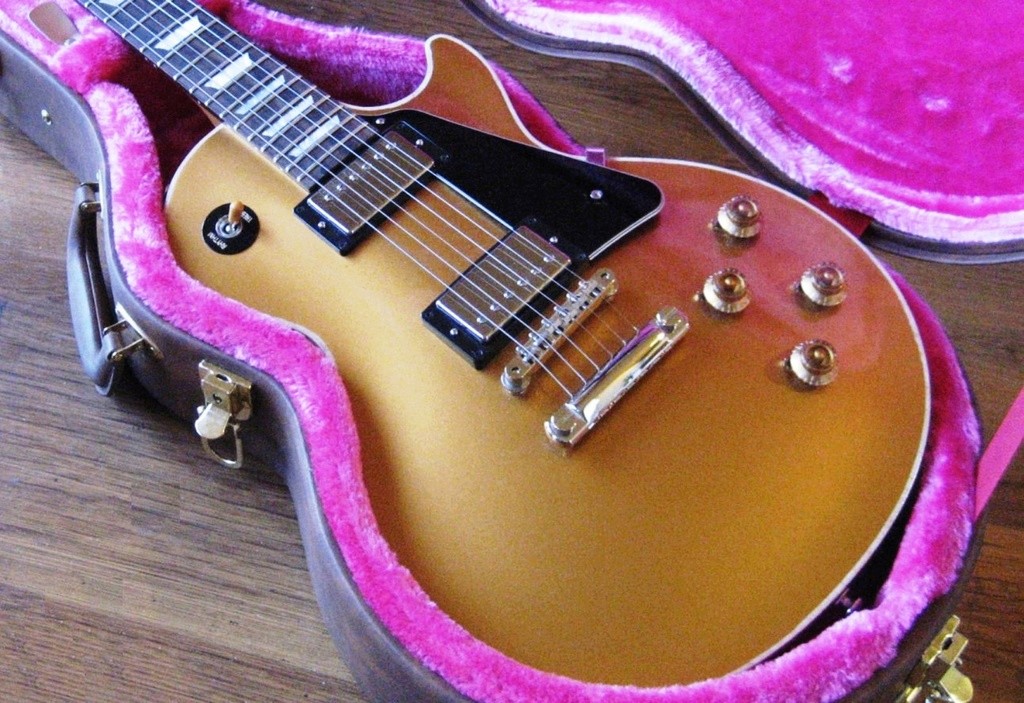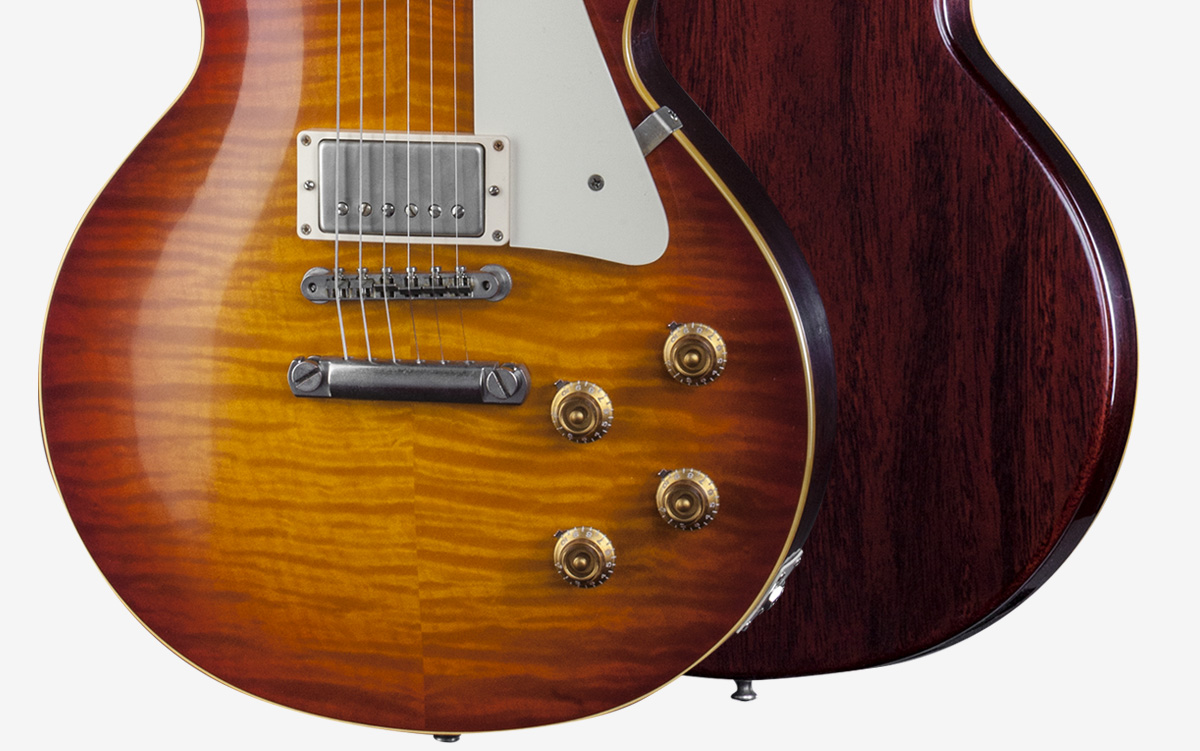Summary: This lightweight alder bodied Les Paul was made in the Gibson Custom Shop division in 1983 and comes loaded with the original Tim Shaw designed humbuckers! This Guitar is a fabulous player with incredible tone- it is really hard to put this one down and was clearly someone’s gigging guitar apparent by the amount of wear around the edges and back. It has just been setup and restrung by our in house guitar tech with low action, straight neck and a new set of 10s. It ships in a vintage Gibson Custom black hardshell case with purple interior.
Body: It has a solid alder body with carved and bound sunburst top with a slightly thin body making it even lighter!
The Gibson Les Paul is a solid body electric guitar that was first sold by the Gibson Guitar Corporation in 1952. The Les Paul was designed by Gibson president Ted McCarty, factory manager John Huis and their team with input from and endorsement by guitarist Les Paul.Its typical design features a solid mahogany body with a carved maple top and a single cutaway, a mahogany set-in neck with a. I was looking at a guitar on Reverb. It’s a Les Paul Lite 120th anniversary. It looks pretty legit but up close you can see there are no fret nibs. Do all Gibson’s have fret nibs?
Neck: Slim tapered mahogany neck with bound rosewood fingerboard, dot inlays, 1.675” nut width and 24.75” scale length.
Pickups/Hardware: 2 incredible sounding Tim Shaw humbuckers with 2 volumes, 2 tones, 3 way toggle, Nashville style tune-o-matic bridge, nickel hardware and Grover tuners.

Cosmetics: This guitar was definitely someone’s main gigging guitar for some time based on the wear- and it should be, this is a fantastic player! There is plenty of wear through the finish on the back exposing the alder body underneath, wear around the edges, plenty of pickwear on the top, lots of shallow dings and dents around the body and some hairline cracks in the binding around the fret ends. The playing surface of the neck is almost entirely blemish free and feels excellent! The ends of frets 4-7 have been worn down and rounded over which gives them a different look than the rest of the frets but it doesn’t impeded playability at all. The frets themselves are in excellent shape with tons of life left in them.

Playability: Our in house guitar tech has just inspected, setup and restrung this guitar with a new set of 10s. The neck is straight, the truss rod is fully functioning and the action has been setup low and comfortable. The frets have plenty of life left in them with no major grooves or divots from use (besides the rounded over ends of frets 4-7) and it plays beautifully up and down the fingerboard with no dead spots or choking out.
Modifications: The tuners have been changed and the previous holes are visible on the back of the headstock.
Weight: 8 lbs, 4 oz.
Case: This Gibson comes with a vintage Gibson Custom hard-shell case with purple interior & we will ship it professionally packed and fully insured!
Refretting a 1959 Gibson Les Paul “Burst”
This 1959 Gibson Les Paul Standard, AKA “Burst” was in need of a refret and a good setup. I photographed the process as I went along. It had been refretted before at some point but the remaining frets were low, flat and not seated well. The fretboard also suffered from unlevelness and a rounded off, uneven radius. Also, with the truss rod fully tightened, there was too much relief in the neck. It would never play well without a refret and correction of the fretboard.
The nut had been shimmed up with various plastics and glue. I’ll give it a solid shim later if the nut is too low after the new frets are in. I adjusted the truss rod so there is room to loosen or tighten it once the refret is complete.
Some loose binding was in need of glue.
With heat from a soldering iron, the frets are freed from old glue and pulled out with minimal chipping.
All the frets are removed, now for the fun part.
Fret slots are “fortified” with ultra low viscosity cyanoacrylate glue(super glue), taking care to glue any chips back in place.
Time to sand! Sanding is done with a machine level sanding bar and adhesive back 120 grit sandpaper. Finer grits will be used later. The bar is run lengthwise along the string line, to insure levelness along each string and to correct the radius at the same time. I’m aiming to maintain a 10 inch radius at the the upper register of the board and a 9 inch radius at the nut. 10 inch radius will accommodate the bridge radius and 9 inches at the nut will give comfort as well as take care of the fretboard roll-off in that area. You can see here there was a deep dip in the board just up from the body joint that was causing a lot of playability issues. You can also see some of the roll-off.
Filling a chip with a teflon dam along the way.
Almost there! I use the little wooden boat sander(seen at the right) to dial in small corrections in radius between sanding with the bar.
The owner decided to go with fret wire of similar dimensions to Gibson factory fretwire from the late 50′s. This wire is .103″ in width.
All fret slots are cleared of glue and debris to an adequate depth and width to receive the new frets. A dremel tool with an adjustable depth setting is great for this task.
A small bevel is given to each slot to help frets sit better and prevent future chipping.
Fretboard is leveled and radiused and fret slots are prepped.

New frets are trimmed and tapped in. Once frets are completely flush and properly seated, a small bead of ultra thin viscosity cyanoacrylate glue is wicked into one side. This is done to prevent future fret “pop out” due to changes in humidity and temperature. I use a swab of vaseline prior to glueing to direct the glue into the fret slot.
All the frets are in!
Gibson Les Paul For Sale
Frets are trimmed to the edge of the binding and beveled with a hand file, then cleaned up with 600 and 1000 grit sandpaper.
Frets are then leveled with the sanding bar and 220 grit adhesive back paper to chase out any minor discrepancies to insure everything is as level as possible.
Used Gibson Les Pauls For Sale
Checking the level.
Fretboard is lightly scraped with a razor blade.
Sanding, cleaning and polishing.
Frets are done, time for the setup!
Here you can see the original red lacquer under the pickguard.
A new shim was needed to achieve the right nut slot height while preserving the original nut.
Setup complete, ready to play!